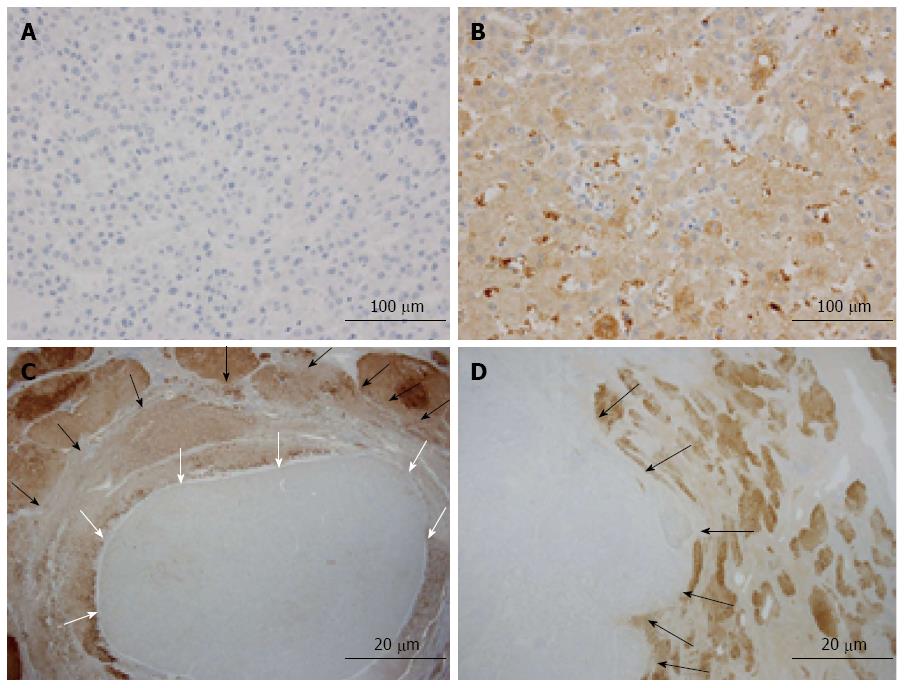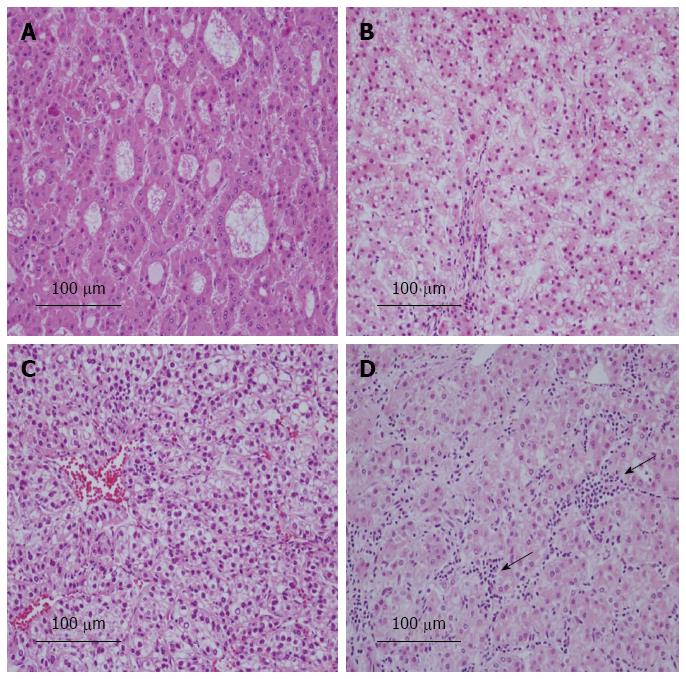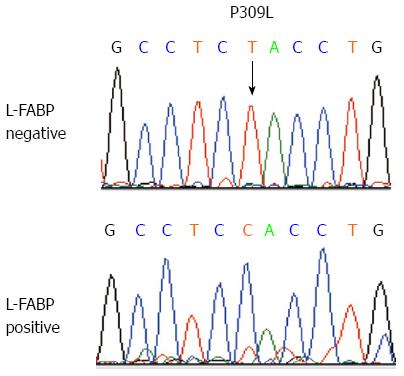Copyright
©2014 Baishideng Publishing Group Inc.
World J Gastroenterol. Dec 14, 2014; 20(46): 17541-17551
Published online Dec 14, 2014. doi: 10.3748/wjg.v20.i46.17541
Published online Dec 14, 2014. doi: 10.3748/wjg.v20.i46.17541
Figure 1 Immunohistochemical staining of liver fatty acid-binding protein in hepatocellular carcinoma.
A: Representative liver fatty acid-binding protein (L-FABP)-negative case of hepatocellular carcinoma (HCC) identified by examination using tissue microarrays; B: Representative L-FABP-positive case of HCC identified by examination using tissue microarrays; C: Focal downregulation of L-FABP expression was observed in a case of small HCC (white arrows show the boundary between L-FABP-negative and L-FABP-positive areas, and black arrows show the boundary between tumorous and non-tumorous areas); D: Diffuse downregulation was observed in a case of large HCC (black arrows show the boundary between tumorous and non-tumorous areas).
Figure 2 Pathological features of liver fatty acid-binding protein-negative and liver fatty acid-binding protein-positive cases of small hepatocellular carcinoma.
A: Most liver fatty acid-binding protein (L-FABP)-negative cases of hepatocellular carcinoma (HCC) were moderately differentiated tumors; B: L-FABP-positive cases of HCC were often well differentiated tumors; C: Intratumoral inflammation was rare in L-FABP-negative cases of HCC; D: Intratumoral inflammation was often observed in L-FABP-positive cases of HCC (arrows) (hematoxylin and eosin stain).
Figure 3 Immunohistochemical features of liver fatty acid-binding protein-negative and liver fatty acid-binding protein-positive cases of small hepatocellular carcinoma.
A: Intranuclear β-catenin was often expressed in liver fatty acid-binding protein (L-FABP)-negative cases of hepatocellular carcinoma (HCC); B: Intranuclear β-catenin was usually not expressed in L-FABP-positive cases of HCC; C: Glutamine synthetase (GS) was often positive in L-FABP-negative cases of HCC; D: GS was usually negative in L-FABP-positive cases of HCC.
Figure 4 Expression levels of liver fatty acid-binding protein and glutamine synthetase mRNA in human hepatocellular carcinoma and cholangiocarcinoma cell lines.
A: Among six hepatocellular carcinoma (HCC) cell lines examined, HepG2, HuH7, PLC, and HuH6 showed higher expression of liver fatty acid-binding protein (L-FABP). However, Li-7 and HLF showed lower expression of L-FABP. In particular, L-FABP expression was almost undetectable in HLF. Expression levels of L-FABP were very low in two CC cell lines examined (HuCCT1 and RBE); B: No obvious correlation was observed between L-FABP and glutamine synthetase expression in HCC cell lines.
Figure 5 Mutation analysis of HNF1A.
One liver fatty acid-binding protein (L-FABP)-negative hepatocellular carcinoma case had a missense mutation (926C>T, P309L), only in the L-FABP-negative tumor area.
- Citation: Inoue M, Takahashi Y, Fujii T, Kitagawa M, Fukusato T. Significance of downregulation of liver fatty acid-binding protein in hepatocellular carcinoma. World J Gastroenterol 2014; 20(46): 17541-17551
- URL: https://www.wjgnet.com/1007-9327/full/v20/i46/17541.htm
- DOI: https://dx.doi.org/10.3748/wjg.v20.i46.17541













